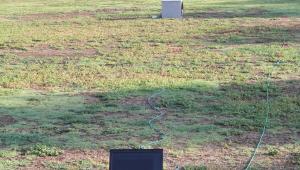Review: Samsung DA-E750 Page 2
Measurements
Frequency response
62 Hz to 20 kHz ±8.0 dB on-axis, ±4.9 dB avg 0-30°
Bass output (CEA-2010A standard)
• Ultra-low bass (20-31.5 Hz) average: NA
20 Hz NA
25 Hz NA
31.5 Hz 83.3 dB
• Low bass (40-63 Hz) average: 101.4 dB
40 Hz 97.4 dB L
50 Hz 101.7 dB L
63 Hz 103.9 dB L
To measure the quasi-anechoic frequency response of the DA-E750, I set it atop a 2-meter stand and placed the microphone at a distance of 1 meter. (Quasi-anechoic measurements eliminate reflections from surrounding objects to simulate measuring in an anechoic chamber.) The microphone was placed on the same axis as the tweeter, then moved around slightly to try to get the flattest response. I then ran a ground-plane measurement at 1 meter to get the bass response; in this case, bass boost was off. To create the graph shown here, I spliced the bass response to the average of quasi-anechoic measurements of the left channel only taken at 0°, ±10°, ±20°, and ±30°. I used a Clio FW analyzer in MLS mode for the quasi-anechoic measurements and log chirp mode for the close-miked sweep, feeding the test signals into the DA-E750’s 3.5mm line input. The quasi-anechoic measurements were smoothed to 1/12th octave. The blue trace shows the 0° on-axis response, while the green trace shows the averaged response.
The DA-E750’s on-axis frequency response (blue trace) doesn’t look terribly smooth, with a dip in response between the subwoofer section and the front woofers at 260 Hz, a narrow -6.3 dB cancellation dip at 1.9 kHz, and rather ragged response above 3 kHz. However, the averaged response (green trace) is considerably smoother. In fact, if you eliminate that dip at 1.9 kHz, the averaged response looks quite smooth from 300 Hz on up. And the balance of bass to midrange to treble is even.
Normally when I measure a speaker dock, I just provide a Bass Limits measurement, because so few of them have useful response in the bottom octave of bass. But the DA-E750’s bass output is comparable to that of a typical subwoofer included with many soundbars, so I’ve included full CEA-2010 bass output measurements here, done at a distance of 3 meters and scaled up to give measurements equivalent to output at 1 meter. (This was taken without the bass boost function on; bass boost seldom affects CEA-2010 measurements, which are determined almost entirely by the properties of the driver, the enclosure, and the amp.) Measurements at which the limit was dictated by the DA-E750’s internal limiter are designated with an L. With 101.4 dB output averaged (in pascals) for 40 to 63 Hz, the DA-E750 delivers the most powerful bass output of any dock I’ve measured.
I like to gauge the output of small audio products with my MCMäxxx™ test, in which I crank up Mötley Crüe’s “Kickstart My Heart” until it sounds distorted then back it off one notch and measure the output at 1 meter. The DA-E750 ruled this test the way the Crüe used to rule arenas, pumping out a solid 100 to 102 dB.
Bottom Line
The DA-E750 doesn’t favor any particular type of music, but a certain type of listener will especially love it: The person who wants to crank up their favorite tunes and enjoy clean sound with serious, foot-tapping bass. And it’s a pretty safe bet that no matter what kind of source devices you own now or will own in the next couple of years, they’ll work just fine with the DA-E750. Plus, of course, you can say your audio system has tubes.
























































